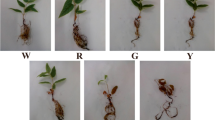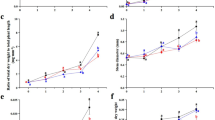Abstract
Alismatis rhizoma is an essential medicine in clinical practice. Asian water plantain (Alisma orientale (Sam.) Juzep) is one of the original plants of Alismatis rhizoma. Previous studies have identified the optimal light intensity range for the growth and development of A. orientale, but the mechanism by which light intensity affects the accumulation of secondary metabolites of A. orientale is unknown. The aim of this study was to investigate the effect of light intensity on the accumulation of triterpenoids in A. orientale saplings and its potential molecular mechanism. The dry weight and contents of total triterpenes and indicative components (alisol B 23-acetate and alisol C 23-acetate) as well as the expression of key enzyme genes in the triterpene biosynthesis pathway under different light intensities (50–600 μmol m−2·s−1) were determined. The results showed that the accumulation of dry matter and the contents of total triterpenes, alisol B 23-acetate, and alisol C 23-acetate increase first and then decrease with increasing light intensity, with the maximum values of 31.65 g, 18.35 mg·g−1, 1.91 mg·g−1, and 0.13 mg·g−1 recorded at light intensities of 400, 200, and both of 300 μmol m−2·s−1, respectively. Light intensities of 200–400 μmol m−2·s−1 promote the expressions of key enzyme genes and the accumulation of total triterpenes significantly. Correlation analysis showed that the expression levels of key enzyme genes are significantly correlated with total triterpene and indicative component contents, and these correlations are strongest under moderate light intensities. Overall, our results reveal that a moderate light intensity of 200–400 μmol m−2·s−1 is beneficial for the growth and synthesis of protostane triterpenes in A. orientale seedlings, and that its probable mechanism involves the upregulated expression of enzymes that are key in the synthesis of triterpenoid ingredients. This study clarified the suitable light intensity range for the synthesis and accumulation of protostane triterpenes of A. orientale, which provided scientific basis for the production of high-quality superior forms of A. orientale.






Similar content being viewed by others
Data availability
The data that support the findings of this study are available from the corresponding author (Wei Gu) upon reasonable request.
References
Appolloni E, Pennisi G, Zauli I, Carotti L, Paucek I, Quaini S, Orsini F, Gianquinto G (2022) Beyond vegetables: effects of indoor LED light on specialized metabolite biosynthesis in medicinal and aromatic plants, edible flowers, and microgreens. J Sci Food Agric 102:472–487
Cheng XY, Ouyang JM (2023) Carboxymethylated rhizoma alismatis polysaccharides regulate calcium oxalate crystals growth and reduce the regulated crystals’ cytotoxicity. Biomolecules 13:1044
Cheng Y, Liu H, Tong X, Liu Z, Zhang X, Chen Y, Wu F, Jiang X, Yu X (2021) Effects of shading on triterpene saponin accumulation and related gene expression of Aralia elata (Miq.) Seem. Plant Physiol Biochem 160:166–174
Choi E, Jang E, Lee JH (2019) Pharmacological activities of Alisma orientale against nonalcoholic fatty liver disease and metabolic syndrome: literature review. Evid Based Compl Alternat Med 2019:2943162
Dou F, Miao H, Wang JW, Chen L, Wang M, Chen H, Wen AD, Zhao YY (2018) An Integrated lipidomics and phenotype study reveals protective effect and biochemical mechanism of traditionally used Alisma orientale Juzepzuk in chronic kidney disease. Front Pharmacol 9:53
Fan J, Jiang H, Sun L, Zhang Q, Liu H (2021) Effect of rhizoma alismatis on the expression of hub genes in the treatment of gastric cancer. Transl Cancer Res 10:4087–4095
Feng L, Liu TT, Huo XK, Tian XG, Wang C, Lv X, Ning J, Zhao WY, Zhang BJ, Sun CP, Ma XC (2021) Alisma genus: phytochemical constituents, biosynthesis, and biological activities. Phytother Res 35:1872–1886
Gao X, Sun C, Yu Z, Cang J, Tian X, Huo X, Feng L, Liu X, Wang C, Zhang B, Ma X (2018) Correlation analysis between the chemical contents and bioactivity for the quality control of alismatis rhizoma. Acta Pharm Sin B 8:242–251
Hernández KV, Moreno-Romero J, Hernández de la Torre M, Manríquez CP, Leal DR, Martínez-Garcia JF (2022) Effect of light intensity on steviol glycosides production in leaves of Stevia rebaudiana plants. Phytochemistry 194:113027
Huang Y, Zhai Y, Huang Y, Huang Y, Liu K, Zhang J, Zhou J (2022) Effects of light intensity on physiological characteristics and expression of genes in coumarin biosynthetic pathway of Angelica dahurica. Int J Mol Sci 23(24):15912
Hwang YH, Kang KY, Lee SJ, Nam SJ, Son YJ, Yee ST (2016) The protective effects of alisol A 24-acetate from alisma canaliculatum on ovariectomy induced bone loss in vivo. Molecules 21:74
Jang E, Lee JH (2021) Promising anticancer activities of alismatis rhizome and its triterpenes via p38 and PI3K/Akt/mTOR signaling pathways. Nutrients 13(7):2455
Ji YY, Gu W, Qiu RL, Tian R, Wei CB, Li T, Zhu Y, Lang PL (2023) Effects of light intensity on growth and physio-biochemical characteristics of Alisma orientale (Sam.) Juzep. Mol Plant Breed 1–14
Kuo CH, Chou YC, Liao KC, Shieh CJ, Deng TS (2020) Optimization of light intensity, temperature, and nutrients to enhance the bioactive content of hyperforin and rutin in St John’s Wort. Molecules 25(18):4256
Li Y, Kong D, Fu Y, Sussman MR, Wu H (2020) The effect of developmental and environmental factors on secondary metabolites in medicinal plants. Plant Physiol Biochem 148:80–89
Libatique MJH, Lee MC, Yeh HY (2020) Effect of light intensity on the mechanism of inorganic arsenic accumulation and patterns in the red macroalga, sarcodia suiae. Biol Trace Elem Res 195:291–300
Luan ZL, Ming WH, Sun XW, Zhang C, Zhou Y, Zheng F, Yang YL, Guan YF, Zhang XY (2021) A naturally occurring FXR agonist, alisol B 23-acetate, protects against renal ischemia-reperfusion injury. Am J Physiol Renal Physiol 321:F617-f628
Pan J, Guo B (2016) Effects of light intensity on the growth, photosynthetic characteristics, and flavonoid content of epimedium pseudowushanense B. L. Guo. Molecules 21(11):1475
Roeber VM, Bajaj I, Rohde M, Schmülling T, Cortleven A (2021) Light acts as a stressor and influences abiotic and biotic stress responses in plants. Plant Cell Environ 44:645–664
Shen J, Wei W, Wang X, Yang J, Lu L, Lv X, Xue X (2020) Proliferation of vascular smooth muscle cells under ox-LDL is regulated by alismatis rhizoma decoction via InhibitingERK1/2 and miR-17∼92a cluster activation. Evid Based Compl Alternat Med 2020:7275246
Shu Z, Pu J, Chen L, Zhang Y, Rahman K, Qin L, Zheng C (2016) Alisma orientale: ethnopharmacology, phytochemistry and pharmacology of an important traditional Chinese medicine. Am J Chin Med 44:227–251
Wang P, Song T, Shi R, He M, Wang R, Lv J, Jiang M (2020a) Triterpenoids from alisma species: phytochemistry, structure modification, and bioactivities. Front Chem 8:363
Wang Z, Xiao S, Wang Y, Liu J, Ma H, Wang Y, Tian Y, Hou W (2020b) Effects of light irradiation on essential oil biosynthesis in the medicinal plant Asarum heterotropoides Fr. Schmidt var. mandshuricum (Maxim) Kitag. PLoS ONE 15:e0237952
Wang D, Yang T, Li Y, Deng F, Dong S, Li W, He Y, Zhang J, Zou L (2022) Light intensity-a key factor affecting flavonoid content and expression of key enzyme genes of flavonoid synthesis in tartary buckwheat. Plants (basel) 11(16):2165
Wu Y, Wang X, Yang L, Kang S, Yan G, Han Y, Fang H, Sun H (2023) Therapeutic effects of Alisma orientale and its active constituents on cardiovascular disease and obesity. Am J Chin Med 51:623–650
Xu X, Li L, Zhang Y, Lu X, Lin W, Wu S, Qin X, Xu R, Lin W (2020) Hypolipidemic effect of Alisma orientale (Sam.) Juzep on gut microecology and liver transcriptome in diabetic rats. PLoS ONE 15:e0240616
Yan P, Wei Y, Wang M, Tao J, Ouyang H, Du Z, Li S, Jiang H (2022) Network pharmacology combined with metabolomics and lipidomics to reveal the hypolipidemic mechanism of Alismatis rhizoma in hyperlipidemic mice. Food Funct 13:4714–4733
Yao L, Lu J, Wang J, Gao WY (2020) Advances in biosynthesis of triterpenoid saponins in medicinal plants. Chin J Nat Med 18:417–424
Zhang LL, Xu W, Xu YL, Chen X, Huang M, Lu JJ (2017a) Therapeutic potential of rhizoma alismatis: a review on ethnomedicinal application, phytochemistry, pharmacology, and toxicology. Ann NY Acad Sci 1401:90–101
Zhang X, Li XY, Lin N, Zhao WL, Huang XQ, Chen Y, Huang MQ, Xu W, Wu SS (2017b) Diuretic activity of compatible triterpene components of alismatis rhizoma. Molecules 22:1459
Zhang S, Zhang L, Zou H, Qiu L, Zheng Y, Yang D, Wang Y (2021) Effects of light on secondary metabolite biosynthesis in medicinal plants. Front Plant Sci 12:781236
Zheng BQ, Zou LH, Li K, Wan X, Wang Y (2017) Photosynthetic, morphological, and reproductive variations in Cypripedium tibeticum in relation to different light regimes in a subalpine forest. PLoS ONE 12:e0181274
Zhou X, Luo J, Lin S, Wang Y, Yan Z, Ren Q, Liu X, Li X (2023) Efficacy of poria cocos and alismatis rhizoma against diet-induced hyperlipidemia in rats based on transcriptome sequencing analysis. Sci Rep 13:17493
Zhu HC, Jia XK, Fan Y, Xu SH, Li XY, Huang MQ, Lan ML, Xu W, Wu SS (2021) Alisol B 23-acetate ameliorates azoxymethane/dextran sodium sulfate-induced male murine colitis-associated colorectal cancer via modulating the composition of gut microbiota and improving intestinal barrier. Front Cell Infect Microbiol 11:640225
Acknowledgements
The authors thank all t the farmers of Alisma orientale in Jian’ou City, Fujian Province for providing seedlings and preserving excellent germplasm. We wish to thank the anonymous reviewers for valuable comments on the manuscript.
Funding
This research was supported by the National Natural Science Foundation of China (Grant No. 82073958 and 81673534), research of assurance ability improvement of Chinese medicinal resources(2023). Data availability The data that support the fndings of this study are available on request from the corresponding author.
Author information
Authors and Affiliations
Contributions
All authors contributed to the study conception and design. WQ Wu and SM Li contributed equally to this work. W Gu and R Tian designed and revised the manuscript. M Luo and JJ Tang performed the experiments and collected data. WQ Wu and SM Li wrote the manuscript. M Tang and YZ Wu analyzed the data. All authors have read and approved the manuscript.
Corresponding author
Additional information
Communicated by V.P. Singh.
Publisher's Note
Springer Nature remains neutral with regard to jurisdictional claims in published maps and institutional affiliations.
Rights and permissions
Springer Nature or its licensor (e.g. a society or other partner) holds exclusive rights to this article under a publishing agreement with the author(s) or other rightsholder(s); author self-archiving of the accepted manuscript version of this article is solely governed by the terms of such publishing agreement and applicable law.
About this article
Cite this article
Wu, W., Li, S., Gu, W. et al. Effect of light intensity on the accumulation of protostane triterpenes in Asian water plantain (Alisma orientale). Acta Physiol Plant 46, 36 (2024). https://doi.org/10.1007/s11738-024-03668-2
Received:
Revised:
Accepted:
Published:
DOI: https://doi.org/10.1007/s11738-024-03668-2




